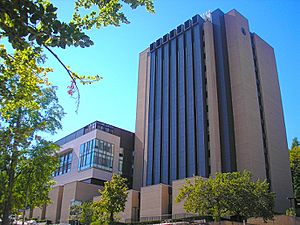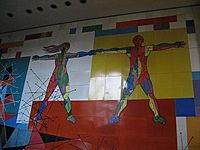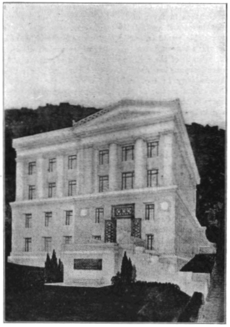Chevron Science Center facts for kids
The Chevron Science Center is a landmark building at the University of Pittsburgh in Pittsburgh, Pennsylvania, United States. It's located at 219 Parkman Avenue. This tall, 15-story building was finished in 1974 and is where the university's chemistry department is based. A new three-story section was added in 2011.
Contents
A Look Inside: What's Here?
The Chevron Science Center is the main place for the University of Pittsburgh's Department of Chemistry. It has big lecture halls, teaching labs, and research areas. Scientists here study many exciting things like organic and inorganic chemistry, how our bodies work (biological chemistry), and how to analyze different substances. They also work on new technologies like nanotechnology, which deals with super tiny materials. Plus, they explore new ways to create energy and develop new medicines and transplant treatments.
The "Science and Mankind" Mural
Inside the Chevron Science Center, near the main auditoriums, you can see a large and colorful mural. It's called "Science and Mankind" and was created by artist Virgil Cantini in 1973. The mural is made of porcelain enamel and shows a man and a woman reaching out to touch hands. This symbolizes the start of life. The colors used on the figures represent different human cells, and the squares and triangles around them show the beginning of the computer age. This huge artwork is 40 feet wide and 30 feet tall, and it was one of Cantini's most favorite works.
History of the Building
Before the Chevron Science Center was built, another important building stood on this spot from 1910 to 1971. It was called State Hall. This was the very first building constructed when the University of Pittsburgh moved to its Oakland campus. Over the years, State Hall was home to the university's library, its main offices, and the engineering department.
The Chevron Science Center cost about $14.7 million to build. Part of this money came from a $2 million grant from the National Science Foundation. When it was finished, it brought many chemistry facilities together under one roof. Before this, they were spread out in eight different buildings across the campus! At the time, it was the largest school building for chemistry teaching and research east of the Mississippi River. The building even won a second-place award in a "Lab of the Year" contest. It also has a large 500-seat auditorium named after Lauren H. Ashe, who was a pioneer in the pharmaceutical industry and a Pitt graduate from 1914.
The building got its name because the Chevron Corporation made a big donation to the university in 1985. They gave the university their Gulf Oil Applied Research Center, which was worth $100 million and included 85 acres of land and all its equipment.
In 2008, the 14th floor of the building was updated with new labs for organic chemistry research. The first floor also got a new electronic library and a café called The Bunsen Brewer. A large new laboratory addition, covering 31,331 square feet, was built above the Ashe Auditorium and finished in 2011. This addition cost $32.4 million.
The Chemistry Department
The Department of Chemistry at the University of Pittsburgh started in 1875. It is now one of the biggest undergraduate chemistry departments in the country. It has also given out over 1,000 doctorate degrees.
Many famous people have studied or worked here. One notable alumnus is Paul Lauterbur, who won a Nobel Prize for helping to develop magnetic resonance imaging (MRI). This is a special way to see inside the human body without surgery. Other alumni and researchers from the department have made important discoveries in areas like recombinant DNA technology (which involves changing DNA), nanotechnology, and alternative fuels. They have also been leaders in creating new drug and transplant therapies.




